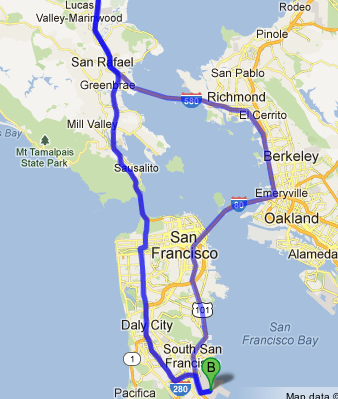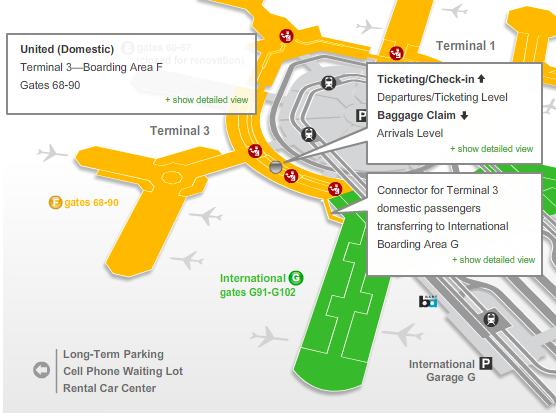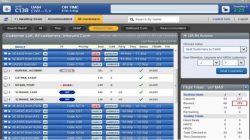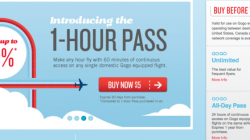Megan and I visited my family in Sonoma County this weekend, and after a day on the lake (where I got too much sun) it was time to get her to the airport. Unfortunately, what we expected to be a 1 hour 30 minute drive was really almost twice that, and Megan arrived at the airport only 25 minutes before departure.
This threw some kinks in our plan that I managed to sort out for the most part. Here are some tips for the next time you find yourself in a make-or-break situation getting to the airport. Since I was staying an extra day to take care of some business, I was able to focus exclusively on getting her there on time. Had we both been late, then I’m sure with the time spent returning the rental and checking the wine we purchased we would have had to rely on our last resort at the end of this list.
1. Know the cut-off times
SFO has a 45-minute cut-off time for checking baggage and 15 minute cut-off time for arriving at the gate for boarding before departure. (The same is true for most domestic airports, but some domestic and most international airports have different rules. Get full lists here for United Airlines, American Airlines, and Delta Air Lines.)
Both of these rules could be waived, of course, but you wouldn’t want to test your luck. I had planned to send Megan home with some checked wine, and that was definitely not going to happen. I was now concerned about her getting to the gate in time. If you aren’t there 15 minutes before departure, the gate staff is within its rights to close the door, and it is VERY difficult to get them to open that door again. Megan arrived at the airport 25 minutes before departure, meaning she really only had 10 minutes before the door closed.
United has the right to cancel reservations, deny boarding and refuse the acceptance of checked baggage of any customer who does not meet their applicable check-in time limit.
2. Know all alternate routes
I saw a real-time traffic update on our way toward Marin that time to the Golden Gate Bridge was 38 minutes away, but it was only 18 minutes to Berkeley via the Richmond-San Rafael Bridge. Had I gone that way, I could have then doubled back across the Bay Bridge and continued to SFO. I wasn’t entirely sure I would come out ahead, so I stuck with my original plan, but at least I considered my alternatives. Especially in a place like the Bay Area with multiple parallel routes, it can pay to use the “show traffic” feature on your phone to get an estimate of which routes are least congested.
3. Check-in ahead of time
I had presciently checked Megan in the night before and sent a mobile boarding pass to her phone. That part was taken care of, so all she needed to do was flash her phone to get through security and onto the plane. Even though we are both fans of paper boarding passes (fewer things to go wrong), in this case it meant one less line in the airport.
Another major benefit of checking in before arriving at the airport is that it helps secure your seat on the plane. In general, if every passenger who has checked in is on the plane, the gate can close early and take off. If you ARE checked in, then they will wait for you up to a point, and that point is the 15 minute rule above. At that point they might give away your ticket unless they absolutely know you’re on your way (like if your inbound flight is delayed, just landed, and you have a tight connection).
4. Know the flight status
We knew from the flight status updates on her phone that her plane was scheduled for an on-time departure, with perfect sunny skies. Ironic given that there was fog barreling down the hillside as we neared the Golden Gate and SFO’s reputation for delays. One other thing we learned was the inbound aircraft, which you can find on United’s mobile app or website. Sometimes the flight still says “on time” even though the inbound aircraft departed an hour later. No such luck this time. If you don’t have this information from your airline, you can also use FlightAware, which has an excellent website as well as a mobile app with which I’m less familiar.
5. Be familiar with the airport
SFO has a priority security checkpoint at the far end of Terminal 3 near the elite check-in desks. If you’re dropping someone off who has elite status, drive all the way to the end of United’s passenger drop off area so that they don’t have to walk any further than necessary. Other airports may have similar arrangements. For example, I know I usually get faster service at the north checkpoint at SeatTac, but late-night departures require me to use the central checkpoint and the priority line is closed so I need to set aside extra time.
Unfortunately, SFO’s priority security checkpoint has bizarre behavior: sometimes it’s empty, sometimes it’s full, and sometimes it’s shut down for no obvious reason. At 7 PM on a busy weekend, it was closed, so my plan backfired and Megan had to walk all the way to the other end of Terminal 3 where the main security checkpoint is located. (There was still another elite line at this location, but she had to walk further than necessary.)
6. Know your gate information
One reason I dropped off Megan at the (apparently closed) priority checkpoint is that we also know she would be taking off from Gate 68. I am familiar enough with SFO that I realized this was directly opposite the usual priority checkpoint. Unfortunately she had to run further and double back, but at least she knew where to go. Had everything gone to plan, it would have been a very quick walk from the car to the gate, but then again, if everything had gone to plan we wouldn’t have been in this mess.
7. The last resort: Invoke the “flat-tire” rule
Many airlines are understanding of unavoidable delays. In our case, we really did try to arrive at the airport on time. But the traffic issues we ran into appeared after we left my dad’s house. In similar cases, or where extreme weather, an accident, or–yes–a flat tire, causes you to miss your flight despite all valiant efforts, explain the situation and ask the gate or ticket agent to place you on standby for the next flight. You won’t depart on time, but you usually won’t have to shell out for a new ticket either. Yes, some airlines really do call this the flat-tire rule.
In the end, everything worked out well enough. Megan got on her plane just in time, I checked the wine with me the next day, and waiting for my bags upon arrival only made us slightly late for an evening appointment. On the other hand, if things had gone wrong, Megan would have missed her flight, the next two were already full, and she might have missed yet another day of work.







